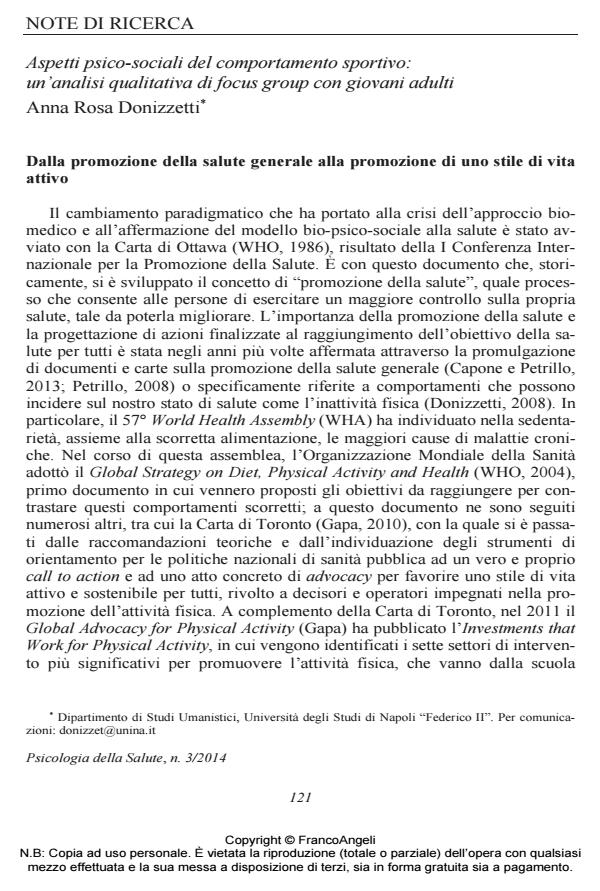Aspetti psico-sociali del comportamento sportivo: un’analisi qualitativa di focus group con giovani adulti
Titolo Rivista PSICOLOGIA DELLA SALUTE
Autori/Curatori Anna Rosa Donizzetti
Anno di pubblicazione 2014 Fascicolo 2014/3
Lingua Italiano Numero pagine 15 P. 121-135 Dimensione file 119 KB
DOI 10.3280/PDS2014-003007
Il DOI è il codice a barre della proprietà intellettuale: per saperne di più
clicca qui
Qui sotto puoi vedere in anteprima la prima pagina di questo articolo.
Se questo articolo ti interessa, lo puoi acquistare (e scaricare in formato pdf) seguendo le facili indicazioni per acquistare il download credit. Acquista Download Credits per scaricare questo Articolo in formato PDF

FrancoAngeli è membro della Publishers International Linking Association, Inc (PILA)associazione indipendente e non profit per facilitare (attraverso i servizi tecnologici implementati da CrossRef.org) l’accesso degli studiosi ai contenuti digitali nelle pubblicazioni professionali e scientifiche
È ampiamente riconosciuto come l’attività sportiva abbia importanti effetti benefici sulla persona non solo dal punto di vista biologico, ma anche psicologico e sociale. Negli ultimi anni l’interesse della comunità scientifica si è orientato alla comprensione dei fattori ambientali, psicosociali e contestuali che possano facilitare od ostacolare l’adesione dei giovanissimi alle attività sportive, dal momento che il periodo dell’adolescenza è quello in cui si registra il più forte calo di partecipazione. Il ruolo di questi fattori risulta, però, poco indagato nelle fasi successive di sviluppo ed in particolare tra i giovani adulti. Alla luce di questi elementi, ci si è posti l’obiettivo di analizzare i fattori che possono incidere sulla partecipazione sportiva di giovani adulti, approfondendo le differenze per pratica sportiva (sedentari, attivi e sportivi). Sono stati realizzati cinque focus group a cui hanno preso parte 33 studenti universitari (13 femmine e 20 maschi) di età compresa tra i 21 e i 34 anni (M = 25.15; DS = 2.87), classificati come sedentari, attivi e sportivi a seconda dei livelli di attività fisica dichiarati. È stata utilizzata una guida per la conduzione dei focus group che sono stati audio registrati ed integralmente trascritti. Per l’analisi dei testi ci si è avvalsi del software T-Lab. Il corpus sottoposto all’analisi è composto da 28.845 occorrenze e 2.743 lemmi. Sono state condotte analisi delle associazioni di parole, delle specificità e delle corrispondenze. Le analisi hanno messo in evidenza visoni differenziate dell’attività sportiva tra i diversi gruppi di partecipanti connesse a differenziati aspetti psicologici. Per i sedentari, emerge un concetto del sé fisico non supportante l’attività motoria ed una mancata o scorretta socializzazione allo sport. Per gli attivi, si rileva il forte fattore motivante del mantenimento o del raggiungimento di una immagine corporea in linea con i canoni imposti dalla società; e per gli sportivi, lo sport rappresenta una strategia di coping e una fonte di benessere. Questi primi risultati offrono importanti spunti di riflessione per la messa a punto di interventi di promozione dell’attività sportiva rivolti a giovani adulti che siano, però, differenziati per livello di pratica sportiva.
Parole chiave:Attività fisica, sport, giovani adulti, aspetti bio-psico-sociali.
- The Relationship between Physical Activity and Psychosocial Well-Being during and after COVID-19 Lockdown Anna Rosa Donizzetti, in Behavioral Sciences /2023 pp.986
DOI: 10.3390/bs13120986
Anna Rosa Donizzetti, Aspetti psico-sociali del comportamento sportivo: un’analisi qualitativa di focus group con giovani adulti in "PSICOLOGIA DELLA SALUTE" 3/2014, pp 121-135, DOI: 10.3280/PDS2014-003007